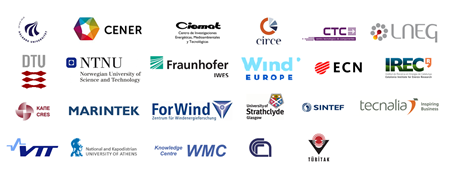This is the seventh bi-annual newsletter for the EERA Joint Programme on Wind Energy (EERA JP Wind) after EERA JP Wind has successfully acquired the EU-funded IRPWind project.
Feel free to distribute the newsletter among your colleagues and friends!

1. EERA JP WIND NEWS
EuropeanWindEnergyProjects.eu
After months of preparation and beta testing, EERA JP WIND has launched the database EuropeanWindEnergyProjects.EU.
The database contains information about publicly funded research projects run by EERA JP WIND members. Some of the EERA JP WIND members have already contributed to the database, and we expect that many more will contribute to help build a platform that shows the breadth and depth of wind energy research in Europe.
The database is a good and very tangible example of what EERA JP WIND and IRPWIND are able to do, but the aim is also to have a useful tool that will allow the wind energy stakeholder community to identify relevant partners from research organisations and academia for future collaboration.
The database is also part of a wider initiative launched under IRPWIND to increase our efforts on data management and open data. We have started a working group to develop a new comprehensible metadata and taxonomy for wind energy research that we hope will become the new standard for wind energy, and a working group under IRPWIND is looking at the opportunities for building better e-infrastructures for wind energy.
Mattias Andersson,
DTU

The EERA DeepWind'2017 Deep Sea Offshore Wind R&D Conference was a success with a mix of plenary presentations with broad appeal and presentations in parallel sessions and posters on specific science and technology themes.
The conference is established as an important venue on deep sea offshore wind R&D organized in association with the European Energy Research Alliance (EERA) joint programme on wind energy. The aim is to present the latest and best on-going R&D on deep sea offshore wind farms.
In total 60 oral presentations and 63 posters were offered addressing new turbine and generator technology, grid connection and power system integration, met-ocean conditions, operation & maintenance, installation and sub-structures, wind farm optimization, floating wind turbines and experimental testing and validation. The conference was fully booked with 200 delegates from all over Europe, and also from USA, China and Japan. In addition to the exciting main event there were side events including a workshop on EERA SP offshore and an IEA Offshore Wind Code Comparison meeting.
The presentations from the conference are available here, whereas selected papers are now in peer-review for publication in the open access journal Energy Procedia (Elsevier).
Mark your calendars: the next EERA DeepWind conference will take place in Trondheim 17-19 January 2018.
![]()
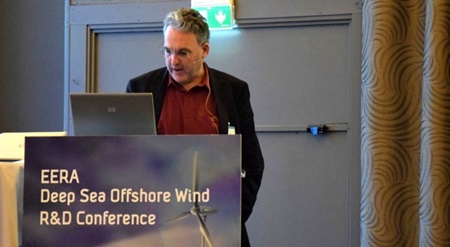
The ETIP wind Strategic Research and Innovation Agenda was presented by ETIP chair Aidan Cronin, Siemens Wind Power, as part of the closing session of EERA DeepWind'2017.

2. EERA JP WIND SUBPROGRAMMES (SP) NEWS
The Sub-Program (SP) on Grid Integration was involved in the drafting of the Strategic Research and Innovation Agenda 2016 (SRIA) of the ETIP Wind in 2016 - specifically for the chapter “Grid Systems, Integration and Infrastructure”. The draft SRIA was distributed to the SP partners with the request for additions and comments and transmitted by the SP coordinator to the ETIP Wind. In autumn 2016, the SP was involved in the Task Force Grids of the ETIP Wind and has prepared proposals for the next Horizon 2020 tenders.

3. IRPWind NEWS
Once again, we can look back at a very successful IRPWind conference in September 2016. During the 2 day event, 45 presentations were held, 12 posters presented and a 121 persons participated. The edition of 2016 saw an increase in participants coming from the industry to over 10%. A large part of the plenary presentations was also provided by our industrial partners, giving insight into the kitchen of their short to middle term projects. Also the European Academy of Wind Energy, the cooperating body of universities and research institutes, presented their vision on the future direction of wind energy research. The informal atmosphere and regular intervals between the presentations gave ample opportunity to network or contact the speakers for follow up on the content. The feedback that was received from the participants through the online survey was very positive and had plenty of suggestions to make this year’s edition even more successful. Please visit www.irpwindconf.eu to download the presentations and posters of the 2016 conference. You are welcome to already register for the conference that will take place on the 25th and 26th of September 2017, in Amsterdam.
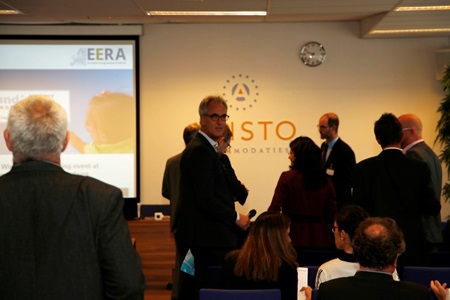
Participants at the IRPWind Annual Conference 2016, Amsterdam.

EERA JP Wind organized an event at the WindEurope Summit 2016 to share the status of the IRPWind project and of the intregration of European wind energy research efforts. Aidan Cronin (Siemens Wind Power), Chair of the European Technology and Innovation Platform on Wind (ETIP Wind), provided the audience with some background information on ETIP Wind’s Strategic Research & Innovation Agenda that was launched only a few days before. EERA JP Wind presented its Technology Transfer Platform, a powerful tool that can help bridging the gap between applied research and commercial introduction of IP and technology that has been developed within the research community. This platform allows the industry to search through “assets”, i.e. research results, that are being uploaded by all EERA JP Wind partners. Some of the assets already avilable on the platform were discussed in groups by interested parties, through a 'match-making' session organised in the second half of the event.
Be sure to visit the Technology Transfer Platform regularly and feel free to suggest improvements!


PhDs in the last two years of their study can now apply for a mobility grant of a duration from 4 weeks to 28 weeks.
Important dates:
Submissions are welcome from now until 31 August 2017. Please note that the grants must end no later than 23 December 2017.
Read more about the Mobility Programme on this link and apply here.
IRP mobility scheme experience,
Luca Greco (CNR - INSEAN, Rome - Italy)
As a Researcher at the National Research Council of Italy (CNR) - Marine Technology Research Institute (INSEAN) I have been working on aeronautical and marine rotary wing systems for the transport sector. My recent interest has been in translating my research to the bordering renewable energy sectors of marine and then wind energy. This interest brought me to work on the analysis of the aero/hydroelastic and aero/hydroacoustic behaviour of vertical and horizontal axis marine and wind turbines and to become the CNR-INSEAN focal point for the EERA Wind Energy Joint Programme. Within this context, the IRP Mobility Scheme represents an interesting and exciting opportunity to spend a work period hosted by a strong European Institution such as the Energy research Centre of the Netherlands (ECN) to strengthen scientific cooperation exploiting the strong complementarity of the two institutes. The vast expertise of ECN on wind turbine modelling as well as testing and CNR-INSEAN focus on rotor aerodynamics, waves/structures interaction along with the capability to test model scale offshore wind turbines in world class facilities, can be exploited to establish a strategic collaboration.
I am at present, half way through my 3-month grant working with Koen Boorsma in the Wind Energy Department on wind turbines aerodynamics modelling. I am convinced that this collaboration will be a contribution to the integration of capacities and resources within the IRPWIND and EERA JP WIND programmes.
The wide network within EERA JP Wind has been fundamental for my application process. In addition, the present running call scheme, with the freedom to choose the length and the period of the mobility, suites very well the needs of experienced researchers to combine work and family life.
On the whole, the IRP Mobility Scheme provides a good opportunity to work in an international, highly qualified and multidisciplinary environment. At ECN, I have found a very friendly and hospitable human environment with a high level of knowledge sharing and empathy. Since the very beginning I have been fully involved in a lot of activities and I have never felt left alone during my stay.
I would definitely recommend the experience of participating to IRP Mobility Scheme!
Anna Maria Sempreviva, DTU
Luca Greco, CNR - INSEAN

For validation of complex wind turbine models, measurement data from scaled physical models or full scaled structures are needed. The more useful data are available for validation, the better the validated models will be in order to predict the behavior of the real structures more precisely in future.
WP6.1 aims to collect existing data from various national and international measurement campaigns to make them easily accessible for a broad user group. The collection of these data is done in a database that is able to handle the huge amount of data that typically arises in offshore measurement campaigns. The database was designed and installed with special emphasis for data from offshore measurement campaigns, including an evaluation of basic statistics and specific descriptions of the structures and the sensors that have been used to create the data. Furthermore, the database provides an easy-to-use download section, enhancing it as a powerful tool for automatized data storage, handling and further processing.
The three basic steps in the development of WP6.1 are:
- Definition of a specification sheet for the database including especially the data exchange format
- Installation and implementation of the database, both hard- and software
- Coordinated collection of measurement data for both floating and bottom fixed offshore wind structures
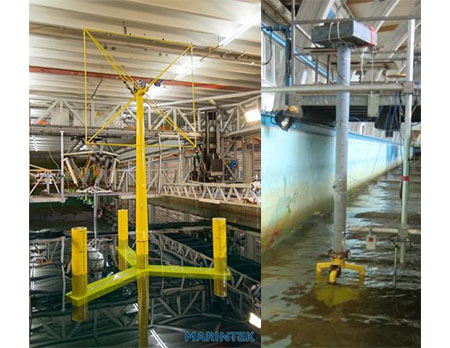
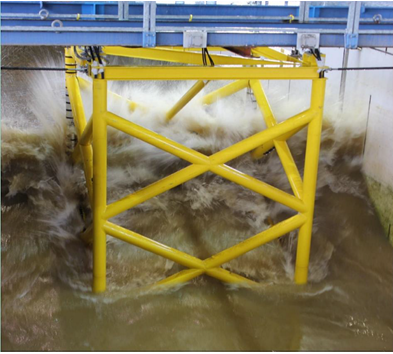
Excerpt of measurement campaigns that have been uploaded: Hybrid testing of a semisubmersible scaled wind turbine (top left), wave slam tests on a jacket-structure (top right), a scaled tripile structure in a wave flume (bottom) and offshore wind farm Blyth (right). More to come.
During the past months, the specifications were defined, the database was installed and the data collection was started and is running now, having measurement data from seven measurement campaigns in the database by now.
The measurement data from the various campaigns and the facilitated accessibility are essential for the tasks to be performed in the subsequent work packages 6.2 and 6.3
The database is available online here.
For information contact: irpwind@isd.uni-hannover.de

The main objective of the overall WP7 is to provide a basis for the validation of structural design methodologies for blades and support structures through combination of experiments and FEM simulations.
Regarding the blade structure, two different subcomponent set ups were designed, the first focusing on the bond line between the spar cap and the shear web (see Fig. A) and the second on the buckling failure mode of the trailing edge (see Fig. B).
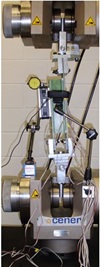
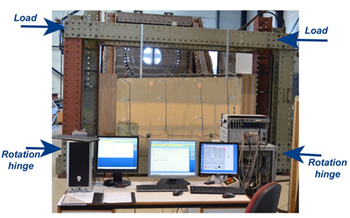
Experimental set-up of (a) I beam subcomponent and (b) blade subpart
Within the third reporting period most of the tests were performed, while the upcoming comparison of the experimental results with FEM simulations aim to the validation or even improvement of the existing design tools. The subcomponents were inspected using ultrasonic, active thermography and précised geometry measurements to identify possible structural defects and include them in the probabilistic analysis for wind turbine blades. Regarding the support structures geotechnical tests were executed to assist probabilistic calculations and evaluate the reliability for offshore wind turbine support structures and their foundations.
In the material level the environmental effects (temperature and moisture) on the fatigue strength of the glass epoxy blade material was investigated. Moreover a state of the art review was conducted on the existing material databases and material models for support structures.
For the last year of the project all the new parameters (experimentally verified uncertainties, model & material properties uncertainties) will be included to the probabilistic design of the blades and support structures.

